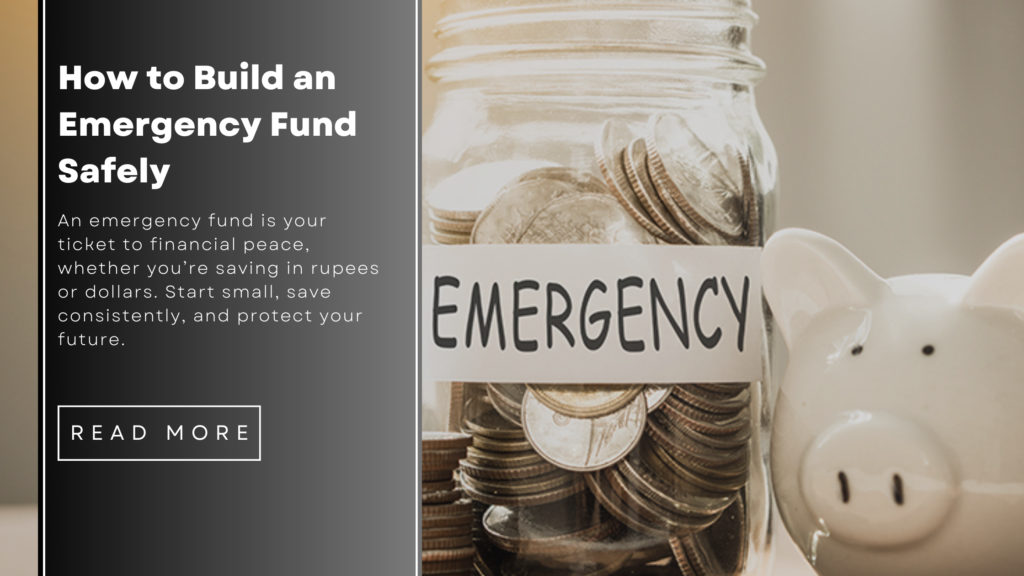What Is an Emergency Fund and Why It’s Crucial for Financial Security, Savings, and Managing Debt
An emergency fund is an essential part of achieving financial security. It’s a dedicated savings pool designed to cover unexpected expenses like medical bills, urgent home repairs, or sudden job loss. Whether you live in India or abroad, building an emergency fund is critical to ensuring you can handle unforeseen financial challenges without falling into debt. In this guide, we’ll help you understand the importance of an emergency fund, how it supports your budget, and how to start building one today to protect your financial future.
Why an Emergency Fund is Crucial for Financial Security
Peace of mind: With an emergency fund in place, you can avoid sleepless nights over surprise expenses, whether it’s ₹10,000 or $100.
Freedom from debt: A well-built emergency fund helps you avoid high-interest loans, be it payday loans in the U.S. or informal loans in India.
Control over your finances: An emergency fund ensures you can face unexpected situations without disrupting your long-term financial goals.
Why You Can’t Afford to Wait for Emergency Fund Savings
Picture this: You’re heading to work when your vehicle suddenly breaks down. The repair bill? A hefty ₹60,000 or $800 (adjusted for purchasing power parity). If payday is still a week away and you lack an emergency fund as a safety net, such situations can quickly escalate into financial crises.
Life is unpredictable, whether you’re living in India, the United States, or anywhere else. This makes having a financial safety net, commonly called an emergency fund, an essential step toward long-term financial security.
How Much Should You Save for Financial Security and Emergency Fund?
The amount you need for an Emergency fund depends on your location, lifestyle, and financial obligations. For instance:
- In India: To build a reliable emergency fund, aim to save at least ₹2,00,000–₹4,00,000 to cover 3–6 months of essential expenses such as rent, groceries, and utilities.
- In the U.S.: A similar benchmark would be $5,000–$10,000, given the higher cost of living.
Pro Tip: Start small. Even saving ₹5,000 or $100 initially builds momentum.
Common Obstacles to Building an Emergency Fund and Managing Finances
No matter where you live, saving for an emergency fund is challenging for similar reasons:
Living paycheck to paycheck: Many individuals in India and abroad find themselves spending their entire monthly income, leaving little room to contribute to an emergency fund.
Temptation to spend: The urge to buy that ₹80,000 smartphone or splurge $1,000 on a vacation can derail efforts to build an emergency fund.
Emergency expenses before building a fund: One unexpected ₹10,000 ($100) medical bill can wipe out early contributions to your emergency fund.
These challenges are universal, but the strategies to overcome them are equally effective, regardless of the currency.
These challenges are universal, but the strategies to overcome them are equally effective, regardless of the currency. If you’re looking for actionable tips to cut expenses and make saving easier, check out this 10 Proven Strategies to Save Money on Everyday Expenses Without Sacrificing Your Lifestyle to take the first step toward building your emergency fund. Also look into How to Build a Personal Budget: Step-by-Step Guide to budget your daily expenses.

Effective Savings Strategies on a Tight Budget for Financial Security
Even with limited resources, saving is possible. Here’s how:
In India: Start building your emergency fund with ₹500 a week by skipping premium coffee shops or cab rides.
In the U.S.: Save $10–$20 weekly by eating home-cooked meals instead of dining out to contribute to your emergency fund.
Small contributions toward your emergency fund add up. For instance:
- Saving ₹500 weekly grows to ₹26,000 in a year, a solid start for an emergency fund.
- Saving $20 weekly accumulates $1,040 annually, strengthening your emergency fund.
Steps to Build Your Emergency Fund and Budget for Savings
Step 1: Assess Your Finances
Calculate essential monthly expenses based on where you live:
- In India: Include rent (₹15,000–₹30,000 in metros), groceries (₹5,000–₹8,000), and utilities (₹2,000–₹5,000) and keep some cash for emergency use , invest the remaining.
- In the U.S.: These costs might translate to $1,500–$2,500, depending on the state and lifestyle.
In case the cash kept in hand for emergency purposes during the month (after covering expenses like rent ₹15,000–₹30,000 in metros, groceries ₹5,000–₹8,000, investments, and utilities ₹2,000–₹5,000) is not spent due to a lack of emergencies, consider this strategic approach:
- Option 1: Directly Add to Emergency Fund: If the amount is manageable, transfer the entire unused cash to your emergency fund. This helps grow your safety net faster.
- Option 2: Split the Amount Wisely: If the unused amount is considerable, split it strategically:
- Allocate 50% (or more based on your needs) to your emergency fund, ensuring it remains robust.
- Invest the remaining 50% in low-risk options like government bonds, gold, or fixed deposits. If you’re comfortable with equities, consider blue-chip companies that offer stability and consistent returns.
This approach not only strengthens your emergency fund but also ensures any excess cash works for you by generating additional returns while maintaining a balanced risk profile.
This helps you estimate the amount needed to cover 3–6 months of living costs.
Step 2: Set a Realistic Goal
Begin with an achievable target. For instance:
- Save ₹50,000 in India or $1,000 in the U.S.
- Once you hit that milestone, aim for ₹2,00,000–₹4,00,000 or $5,000–$10,000.
Step 3: Budget for Savings
Identify areas to save:
- In India: Cut discretionary spending on dining out or streaming subscriptions like Netflix and Amazon Prime.
- In the U.S.: Reduce costs by shopping with coupons or switching to generic brands.
For example:
- Skipping ₹300 worth of chai or $5 lattes daily can save ₹9,000 or $150 per month.
Step 4: Automate Your Savings
Set up automatic transfers:
- In India, use platforms like UPI-linked savings apps or recurring bank transfers to direct ₹2,000–₹5,000 into a high-yield account monthly.
- In the U.S., automate $50–$100 into a savings account weekly.
Best Places to Keep Your Emergency Fund forc Financial Security and Growth
The ideal place for your emergency fund balances safety and accessibility. Options include:
- In India:
- High-yield savings accounts offering interest rates of 6%–7%.
- Liquid mutual funds, which offer higher returns while keeping funds accessible.
- In the U.S.:
- High-yield savings accounts with APYs of 3%–4%.
- Money market accounts, which combine safety and modest returns.
Staying Motivated to Save and Reach Financial Security Goals
Celebrate Milestones
Whether you’ve saved ₹25,000 or $500, treat yourself to something modest to stay encouraged.
Visualize the Benefits
Imagine avoiding the stress of borrowing ₹1,00,000 or $2,000 in an emergency. Visualizing your goal keeps you on track.
Mistakes to Avoid When Managing Your Emergency Fund and Savings
Using the Fund for Non-Essentials
Avoid spending your emergency fund on discretionary items like a new ₹1,50,000 TV or a $2,000 vacation.
Neglecting Other Financial Goals
Balance saving with paying down debts like credit card bills or loans. For instance, focus on clearing high-interest debt first (above 12% in India or 20% in the U.S.).
How an Emergency Fund Reduces Stress and Enhances Financial Security
Regardless of where you live, having an emergency fund offers:
- Confidence: Whether you’ve saved ₹2,00,000 or $5,000, you’ll face life’s uncertainties with ease.
- Freedom: No more relying on credit cards or payday loans.
- Peace of mind: Knowing your finances are secure lets you focus on what truly matters.
Take Control of Your Finances and Start Building Your Emergency Fund Today
Don’t wait for the next emergency to hit—start building your safety net today.
Action Step:
- Open a high-yield savings account in India or the U.S.
- Automate a weekly deposit of ₹500–₹2,000 ($10–$50) to kickstart your fund.
Bonus Tip:
Share this guide with a friend or family member and start a savings challenge together. Financial goals are easier to achieve with accountability!
FAQs About Emergency Funds
What should I use my emergency fund for?
Your fund is strictly for true emergencies, like medical bills, car repairs, or urgent home repairs, whether it’s ₹10,000 in India or $200 in the U.S.
How much should I save?
- Start with ₹50,000 or $1,000, then aim for 3–6 months of essential expenses (₹2,00,000–₹4,00,000 or $5,000–$10,000).
Can I use the fund for planned expenses?
No. Keep your emergency fund intact for unplanned events only.
Where should I keep my emergency fund?
- In India: High-yield savings accounts or liquid mutual funds.
- In the U.S.: High-yield savings or money market accounts.
How do I rebuild my fund after using it?
Prioritize replenishing your fund as soon as possible, even with small amounts like ₹2,000 ($50) monthly.
Conclusion: Secure Your Financial Future with an Emergency Fund
An emergency fund is your ticket to financial peace, whether you’re saving in rupees or dollars. Start small, save consistently, and protect your future. You’ve got this!



